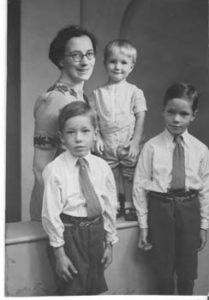
My Memories
From 1945- 1955
My Father worked at the Monotype factory in Salfords Surrey. When I asked him why he was not in the Army or Air Force he explained, as a Turner he was required for important war work and it was called a “Reserved Occupation.” However he did tell me when we were older that had he been called up he would have been a conscientious objector. This often gave me cause for concern especially later in life.
It was not very long before I slowly realized we had been born into a rather unusual household. It took time to sink in but we really were treated different to other families in the street and other children at the school. Of course this was not a physical thing but a religious dogma that my parents insisted was the right Christian way. Having spent all my life trying to come to terms with their beliefs, I am still totally baffled by their teachings. Furthermore I believe myself and many others have been damaged by this movement.
They were known as the Exclusive Brethren and they follow the teachings of John Nelson Darby and others. They believe in separation from the world and its people as far as possible. One of the things they disliked and still do is radios and televisions. Times and beliefs appear to have changed over the years, It’s got much worse.
Gradually and slowly it was becoming apparent to me that whatever we, my twin brother Charles and I enjoyed doing as children our parents raised some objection or other when we asked, “why not?” The usual answer was, “because it’s worldly”. One or two examples, when we were about 9 years old we went along to see the Cubs Scout organization situated in a small village nearby in Salfords. We joined in secret, but it was not long before my father found out and we had to leave. It was the same story with the Church Lads Brigade, but I seem to remember we lasted a bit longer before we had to leave, it made me feel so down at the time it seemed to me we were not allowed to do anything, —–except go to the church meetings of the Brethren. It became clear to me to be just meetings and more meetings. Three times on a Sunday, and my father went many times in the week as well.
It’s my firm belief that my father neglected family life in order to look good in the eyes of the local leaders of the Brethren. The meeting room was an utterly depressing building in Calerndon Road Redhill,
{Now demolished}. The meetings were just as bad with the same format every week.
From memory: the Morning meeting, arrive at about 10.45 and it always seemed at the last minute, the ladies would arrive bustling in, they were for the most part a buxom lot with large fancy hats. At 11.00 everything fell quiet, until a brother who was apparently moved by the spirit would start to pray. When he sat down another –long— silence, and then another brother would announce a hymn number. After a pause someone would start to sing and everybody would join in. Just sometimes they got it wrong, i.e. perhaps they started too high or the tune would not fit the words. They had to stop and start again, no piano or organ just join in on the tune which appeared to be randomly selected if that was possible.
After another embarrassing long silence, {apart from nose blowing and eye wiping with crisp white handkerchiefs,} another brother would read from the Bible and then a discussion would begin with only the men ever taking part. Then about half way through the meeting the Breaking of Bread would take place which seemed to be the most important act of the meeting. Women and children had to remain silent at all times. I was a fidget and could not sit still for long, especially if there was a toilet requirement, and with me that was often the case, but to go out to the toilet would have been frowned upon so much and well I knew it.
During these long and boring meetings my attention slipped to other matters. Usually sat in front of me were a row of men, one was a Mr. Dunn** who has remained transfixed in my memory all these years. At that time I hated him I used to look at the back of his neck and the bristles of hair and imagine pulling them out one by one, thus causing him pain. Mr. Dunn had a son Charles and two daughters Elizabeth and Mary, Mary always seemed a bit tearful.
Others I remember well were a Mr. Silcock who seemed to grunt a lot, a Mr. Fowler who was a little man with a big wife and daughter. One Sunday morning when leaving the meeting Mrs. Fowler looked at me straight in the eye and asked “Michael, is your heart clean”? I mumbled, “I think so,” and then tried to imagine that thing inside my chest with blood in it beating away and whether it was clean or dirty, that question bothered me for some time. Needless to say she would have received a very different answer now I am older, and a grumpy old man.
Afternoon meetings thankfully went a bit quicker with a few hymns and Bible readings. I know we went to them but nothing really sticks out in my mind as worth recording. It was quite well known that I was not happy always going to meetings.
The evening meetings were for me the worst, I believe they started at 1830 usually with a visiting preacher. First a Hymn, then a prayer to ask for guidance, and then the preaching, this would start about 1838 and was usually an absolute bore. The preacher would read a few verses from the Bible and for the next 50 minutes he would put his interpretation on what he had just read to us. When he ran out of words he would start to repeat himself and get louder, that was the usual pattern. I could not help myself, I just watched the clock which was situated just above and behind the preacher, and he in turn always seemed to be watching me. Well that’s what it felt like. If they started to go past 1930, inwardly I would get very angry. I never got anything from these meetings and that’s partly the cause of my rebellion.
I remember acts of kindness being shown to me by two Brethren members, and I think it is right that I record them. Mr. Ghinn took my brother and I to Box Hill in Surrey on Wednesday 10th of August 1949 in his large Packard Car, we both really enjoyed the outing. Some may ask, how do you remember the date? How could I forget, it was the day that John George Haigh* was executed for the acid bath murders.
Another gentleman by the name of Mr. Sidifin he took us for a ride in his smart Vauxhall Wyvern to the south coast for the day and brought a nice tea near Rottingdean.
*John George Haigh (24 July 1909 – 10 August 1949), nicknamed the “Acid Bath Murderer”, was an English serial killer during the 1940s. He was convicted of the murders of six people, although he claimed to have killed a total of nine, dissolving their bodies in concentrated sulphuric acid before forging papers in order to sell their possessions and collect substantial sums of money. He acted under the mistaken belief that police needed a body before they could bring a charge of murder. He was convicted through forensic evidence and executed.
Haigh was born in Stamford, Lincolnshire, and grew up in the village of Outwood, West Yorkshire. His parents, John and Emily, were members of the Plymouth Brethren. He was confined to living within a 10 ft (3 m) fence that his father put up around their garden to lock out the outside world. Haigh would later claim he suffered from recurring religious nightmares in his childhood.
Mr. And Mrs. Ghinn who owned a large local business. He often spoke to us and that was to ask myself and my brother Charles to lunch and tea, that way we felt duty bound to go to all three meetings. They had a servant I think his name was Hands, a black man, he was the first black man I ever remember meeting. The food was good and plenty and we were grateful. However, we soon cottoned on to the fact that they had found a way to get us to every meeting, well, we had other plans and one Sunday when they asked, “would you like to join us today?” We just answered, (to my parents horror), “no thank you.”
As mentioned in another chapter my father did stray from the pathway a few times by going to the cinema. My Mother accused him of having an affair with a young lady who lived just down the road from us, but I doubt that very much.
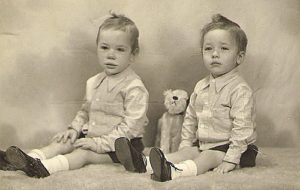 My twin brother Charles (left) and myself (right)
My twin brother Charles (left) and myself (right)
The teddy belonged to the photographer.
C 1945
When we were very young we did have a Radio for a short time. I loved it but sometimes we would have a visit from the elders of the Church to check up on us. The visits I remember were in the winter sometime after 8pm. If there was a knock on the front door we would rush to turn the radio off which was in the back room, then cover it up with a blanket or something handy. And guess what? Usually, it was that Mr. Dunn and his sidekick a Mr. Silcock; they never came on their own. Mr. Dunn would ask the questions and Mr. Silcock would chip in with a grunt and say, “we are only trying to help you St–an–ley” (my father) in a slow dragging tone, they used to interrogate him about his movements and his absence from the meetings.
We were often sent to bed but my Mother, when pressed often let us in on the content of the proceedings. And we would sometimes creep downstairs to listen to most of the conversation. I firmly believe my Father was easily led. One night I was elected by my brother to pass Mr. Dunn a note, saying something like, “Go away we do not like you.” He read it and passed it straight back to me with an arrogant smirk on his face, that was our protest over. These men and the brethren will never know the damage they caused in my life as a young child.
I believe they have all passed on but many have descendents still in the system, they should face up their transgressions because to a large extent the current leaders still work the same way today. The sad thing about Mr. Dunn is that later in life he committed suicide.
Tears of a young Rebel
It was late summer in 1950, I was 9 years old. I and my twin brother Charles were visiting Aunty Grace with our parents; they lived in Down Ampney near Cirencester. Grace was a half sister of my mother; Grace had married Philip Herbert a baker in the village. We arrived on a Saturday afternoon, Aunty Grace sent us straight upstairs for a bath. I could not understand why, we had had one before we left home in Redhill. In hindsight it was probably to talk in private with my parents. Soon after the bath we had some tea, later a short walk in the village and then it was time for bed. Wakening up on the Sunday morning it dawned on me, I would be stuck with Brethren Church meetings all day, I believe the meeting room was very close by and I knew exactly what would happen, plus the fact we were to return home on the Monday. What a way to spend a holiday!
I was not impressed and decided to run away, soon after breakfast I planned my escape. Just before we were all due to leave and whilst the adults were busy preening in the mirror, I slipped out of the back door and ran away as fast as possible. First down the garden path and into a field, then just ahead and to my right was a large cornfield. It was ripe and ready for harvesting. I ran around the edge for quite some time, then there was a hedge to my right and the cornfield to my left, I started to crawl into the cornfield on all fours. I was trying to move quickly and quietly, at times changing direction and moving towards the centre of the field.
Finally I found a good place which must have been near the middle of the field, I sat down and cried and the tears rolled down my cheeks. I had to stop crying as maybe someone would hear me. I managed to remain silent but I was still shaking. Some time later I could hear my father calling “Mike, Mike”. I did not answer him, a little later I heard him again but this was a more distant call. He was moving further away, I was safe. It was a long hot day sat in that corn field and I dare not move, I just sat quietly losing myself in my own imagination, it still to me is the best way of passing time when unable to do anything else.
The minutes and hours were ticking by. With no watch there was no way I could tell the time, I stayed there, much later when it seemed the sun was setting I found my way back to the house. I had missed lunch and teatime. I got a very cool reception, but they spared me the usual interrogation. Later I was given some tea, and then I was sent to bed. And, we did return home the next day.
Festival of Britain 1951
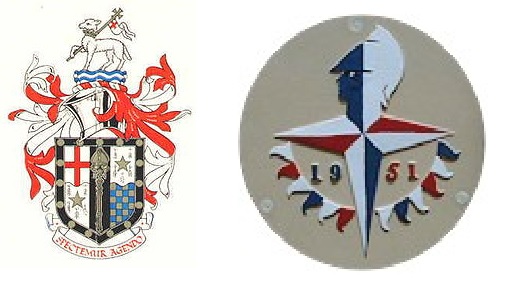
Great Britain was still in the austerity years, it was just 6 years after the end of the Second World War. Food rationing was still a part of everyday life, and I was 10 years old. Quite unexpectedly one Saturday my father called my brother and me into the house. He explained we were going on a train to London to visit the Festival of Britain. This Festival was a great celebration, it was opened by H.M. King George 6th on the 3rd May 1951 and it was a hundred years after The Great Exhibition of 1851.
This was a most unusual action for my Father as we lived in a very strict household with strong beliefs; for example we were not allowed a radio and never allowed to join clubs or go to a cinema as this sort of activity was considered sinful and of the world. Therefore this was a real good time for us and so exciting. My Father I guess was going off the straight and narrow path at this time.
Construction of the South Bank site opened up a new public space, including a riverside walkway, where previously there had been warehouses and working-class housing. There was, however, opposition to the project from those who believed that the money would have been better spent on housing. A film was made about working-class resistance to the demolition that the festival required and featured a London family barricading themselves into their terraced house to prevent it being demolished to make way for the Festival of Britain. The house is finally saved when red-faced Whitehall bureaucrats decide to feature it in the Festival as a “typical English home”.
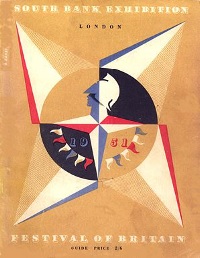
In 1948, the architect Hugh Casson 38 was appointed director of architecture for the Festival and he broadmindedly sought to appoint other young architects to design its buildings. He was knighted in 1952 for his efforts in relation to the Festival.
Left: Abram Games was the designer who created the famous Festival symbol.
The layout of the South Bank site was intended by the organisers to showcase the principles of urban design that would feature in the post-war rebuilding of London and the creation of the new towns.
These included multiple levels of buildings, elevated walkways and avoidance of a street grid. Most of the South Bank buildings were modern in style, little seen in Britain before the war. All except the Royal Festival Hall were later destroyed by the incoming Churchill government in 1953, who thought them too ‘socialist’ for their taste.
Our first visit was to the funfair in Battersea Park, known as the Pleasure Gardens the thing I remember most was John Collins Big Dipper, a big fairground ride. We were not allowed near it but we were able to watch. There were many others and I yearned just to have one ride, but it was not to be.
I do not remember if we got a train or a bus, but at some time we arrived at another area. Then there was a place called the Dome of Discovery, what a place! My first memory was moving stairs. I just could not understand this because at the top of this staircase they all disappeared.
The dome had a diameter of 365 feet and stood 93 feet tall making it at the time the largest dome in the world. It was constructed from concrete and aluminum in a modernist style and housed many of the festival attractions. Internally the dome included a number of galleries on various levels housing exhibitions on the theme of discovery — the Living World, Polar, the Sea, the Earth, the Physical World, the Land, Sky and Outer Space.
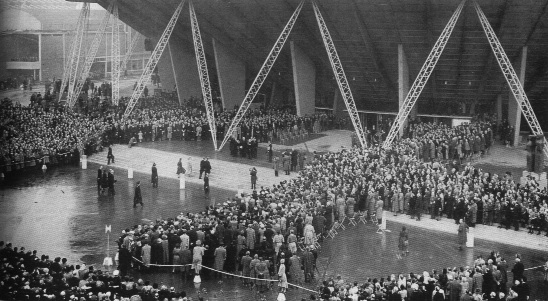
Like the adjacent Skylon tower, the dome became an iconic structure for the public and helped popularize modern design and architectural style in a Britain still suffering through post-war austerity. Controversially after the Festival closed, the dome was demolished and its materials sold as scrap. The site was cleared for reuse, and is now the location of the Jubilee Gardens, near the London Eye.
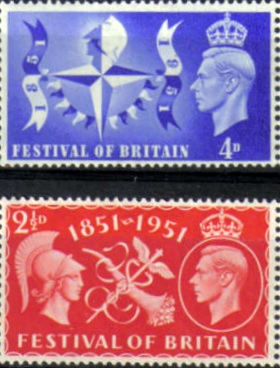
Right: Festival of Brittan Stamps
There were planes hanging from ceiling, and steam engines on display. Many times that evening I had to be dragged away, everything was so interesting.
I was spending too much time in wonder and amazement.
At some time in the evening we entered a small enclosure. There in front of my very eyes was a Magician! I could not understand or believe what was happening. He was picking coins out of the air and dropping them in a silver bucket, and then he took a silver half crown from my ear. He cut up rope and suddenly it was restored. He produced a dove from a piece of silk; I was amazed. This started my mind working and the seed was sown. But it was not until much later in life that I managed to realize a long held ambition and become a Magician myself. This happened some 51 years later on the 20th may 2002 when I passed the examination in London at the Magic Circle H. Q.
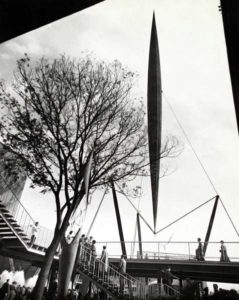 We went outside and stood under the Skylon, a futuristic giant silver cigar shaped column. It had internal lighting and was held in place by cables. It rose 250 feet into the air. There was a mark to stand on so that we knew we were directly under this great creation.
We went outside and stood under the Skylon, a futuristic giant silver cigar shaped column. It had internal lighting and was held in place by cables. It rose 250 feet into the air. There was a mark to stand on so that we knew we were directly under this great creation.
The Skylon: consisted of a steel latticework frame, pointed at both ends and supported on cables slung between three steel beams. The partially constructed Skylon was rigged vertically, and then grew taller in situ.
The architects’ design was made structurally feasible by the engineer Felix Samuely who, at the time, was a lecturer at the Architectural Association School of Architecture in Bedford Square, Bloomsbury. The base was nearly 15 meters (50 feet) from the ground, with the top nearly 90 meters (300 feet) high. The frame was clad in aluminum louvers lit from within at night. Both the name and form of the Skylon perhaps referred back to the Trylon feature of the 1939 World’s Fair. Mrs. A G S Fidler, wife of the chief architect of the Crawley Development Corporation, suggested the name and said she derived from skyhook and nylon.
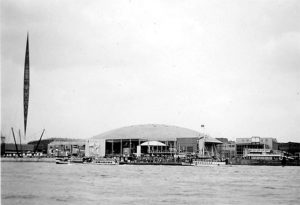 A few days before the King and Queen visited the exhibition in May 1951, Skylon was climbed at midnight by student Philip Gurdon from Birkbeck College who attached a University of London Air Squadron scarf near the top. An unfortunate workman was sent up a few days later to collect it. Questions were asked in Parliament regarding the danger to visitors from lightning-strikes to the Skylon, and the papers reported that it was duly roped off at one point, in anticipation of a forecast thunderstorm.
A few days before the King and Queen visited the exhibition in May 1951, Skylon was climbed at midnight by student Philip Gurdon from Birkbeck College who attached a University of London Air Squadron scarf near the top. An unfortunate workman was sent up a few days later to collect it. Questions were asked in Parliament regarding the danger to visitors from lightning-strikes to the Skylon, and the papers reported that it was duly roped off at one point, in anticipation of a forecast thunderstorm.
I am not sure of the location but towards the end of the evening we sat down near some fountains and a lake. Suddenly there was a very loud bang. A firework display had started and what a great display it was! I had never seen anything like this before. It was a super end to a wonderful outing. Soon it was time to return home to Redhill. I do not remember much about the return journey. My mind was to full of other things—– especially the Magician!
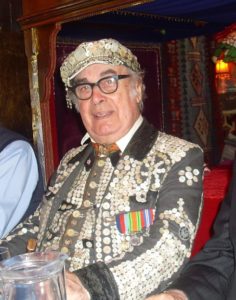
Mr. Larry Barnes MIMC
The Viceroy of Versatility
Larry Barnes served in the Royal Artillery before embarking on his career as a man of many parts – from straight actor (Edmund in King Lear) to stunt man – he is a horseman, archer, swordsman and escapologist. A member of the inner Magic Circle, he is also a lightning cartoonist, balloon sculptor and paper-tearer. Larry is the Pearly King of Thornton Heath and often illuminating his act by appearing in his uniform. It was some 60 years later that by chance I found out that it was Larry who preformed at The Festival of Britain, we often had lunch together.
Cycling from Earlswood
1954
Most children at one time or another enjoy cycling and I was no exception. In fact at 74 years of age I still cycle but it must be stated, these days I am a fine weather and quiet road person. I am now 76 so have stopped cycling altogether. My wife found it difficult to believe I used to ride such distances when I related my cycling stories to my family. I was very proud of my cycle. I had started with second-hand cycles, later I had a Phillips which was also second-hand but a very good cycle, then when I could afford it graduated up to a new Dawes. To me it was the best cycle I ever had. I saved the monies from a part time job I had as a grocer’s delivery Boy.
My mother had decided we would visit her mother who lived in South Cerney Glostershire, we were to go by train; I had other ideas, and immediately started making plans. I was a member of the Youth Hostels Association (Y.H.A.) and this was a great help in forming my plans.
First I studied the maps to decide a possible route. Next I looked in the Y.H.A. Handbook to see if there were hostels near the route I intended to take, there was. My plans were going well. The first leg of the route was going to be the longest; I figured it would be some 80 miles that I would have to cover on the first day.
This was from our house in Wimbourne Avenue near Redhill in Surrey to near Marlborough in Wiltshire. As I write this story I have just checked the mileage more accurately, I discover the mileage covered on the first day was just over 100. I had sent a note to the Hostel a few days before to book a bed for the night. I set off at about 7 in the morning it was summer and fine weather. The route was as I had planed and I made good progress .The towns I passed were Reigate, Dorking, Guildford, and then north towards Reading, on to Newbury, Hungerford, and Marlborough. The hostel was about two miles further on from the centre of Marlborough and situated on the A4 towards Chippenham. The journey had taken about eleven and a half hour’s I had taken a short stop for sandwiches. Surprisingly I felt fine and looked forward to the next day; this would be a shorter trip. The hostel was comfortable and I had a good nights rest, there was a first class breakfast in the morning, and I helped with the washing up afterwards. (This was one of the hostel rules in those days) I was soon on my way, first back to Marlborough. Then turn north towards Swindon and then on to my destination near Cirencester. I arrived in South Cerney at about 1500. This had been a much shorter distance than the previous day, a distance of 25 miles. I was greeted warmly by my Mother and the Family. My journey was not over;
I was less than half way through. I was in for a new experience and another great memory. At about 1900 that evening I cycled to Ashton Keynes, where I had booked another hostel; this is a small village about 3 miles distant from South Cerney. From memory it was an old country farmhouse set in beautiful countryside. I listened to the radio with other guests and exchanged cycling stories, then went to bed in a dormitory at about 2200. In the morning and after another good breakfast I helped with weeding the garden, there were three of us and we soon had the task finished. I then set off to return to South Cerney.
My Mother and Grandmother were discussing a visit to Bristol where we had more relations. My mother would go by train from Kembel, and she wanted me to stay at South Cerney and return home the next day;
I wanted to cycle to Bristol, eventually it was agreed. I set off before they changed their minds. Bristol was 42 miles away and we had more relations living there by the name of Doling; they lived in Sefton Park Road.
I could afford to take my time on this ride, I was getting used to timing my distances. I had taken to some back roads for several reasons first to avoid traffic, and it was the more direct route, although the traffic was nowhere near as bad as it is today in 2006.It was a beautiful day and I was going well,
I was not far from the village of Lucklington between the towns of Malmesbury and Chipping Sodbury, there was a field to my left with a five bar gate and a lay by. There was some activity in the field, and two old farm wagons were parked just in the field behind the hedge.
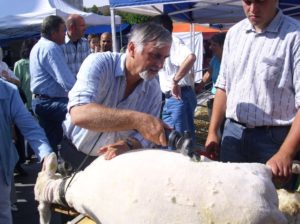 Laying my cycle to one side and taking a peek over the Gate, I discovered the work was in progress, sheep sheering! Having never seen this before or since this was exciting. I watched with great interest for about 15 minutes. The farmer looked up. “Fancy a go at this boy?” I needed no second invitation; I climbed straight over that gate. I was soon under instruction, first I had to catch the sheep, and they were all in a pen waiting their turn.
Laying my cycle to one side and taking a peek over the Gate, I discovered the work was in progress, sheep sheering! Having never seen this before or since this was exciting. I watched with great interest for about 15 minutes. The farmer looked up. “Fancy a go at this boy?” I needed no second invitation; I climbed straight over that gate. I was soon under instruction, first I had to catch the sheep, and they were all in a pen waiting their turn.
Sheep Shearing
Photograph Mick Gurr
Next select one, this done, take the animal to the shearing area and bring it to the ground. I must stress at this point the following account is from memory, and is not necessarily the right way to shear, or catch a sheep.
Grab the sheep’s two hind legs and turn the animal on to its side, hold it down with one knee on the animal and one on the floor. Once the sheep has stopped wriggling, take the shears, and turn them on. Start at the neck working towards the back. Take care not to cut the animal by going to close to the skin. Once one side is complete roll the sheep over and do the same on the other side. Try your best to keep the entire fleece intact. It was my first and only attempt, unfortunately I did cut the sheep, but not to seriously and the fleece was in three parts. However a great experience. I thanked the farmer. “Not bad for your first try lad” he said giving me a pat on the back. I felt good about that comment. I was soon on my way to Bristol, it was an uneventful ride.
One thing I had overlooked, and that was to book accommodation in the Bristol Hostel. “Well,” said the man who answered the phone. “You should really book two days in advance for this hostel, but we have a place in the dorm, see you later.” This Hostel was a tired looking place and so were the people running it, that’s about all I remember. The following morning I was back in Sefton Park Road, Uncle Cecil was a nice man and a factual sort of chap. We seemed to get on well, however there were other things on my mind. It occurred to me that I did not want to be around on Sunday or else I would be trapped and be obliged to attend the Brethren Sunday meetings.
It was a Thursday. I set off and cycled the same route on my return journey, and I stayed at the same hostels. The whole trip was rather uneventful. But I had a near miss accident with a motorcycle and some pedestrians in the town of Chipping Sodbury. I arrived home on the Sunday evening; everything had worked out so well. The total miles covered were 341.
Cycling — London — Brighton
London
It must be remembered that the roads and London were a lot safer than they are now. Not so much traffic and a lot less crime. We never locked our cycles and they were always in the same place when we returned. We were often told by adults “if you are in trouble, speak to a policeman or a man in uniform.” There were plenty of them around in the early 1950s.
I think London was my favorite trip, because there was always something going on. All those large buildings, and we had to find our way round usually by asking people, and they were always helpful. The markets round the east end were wonderful places. Petticoat Lane, Brick Lane, and others all within walking or cycling distance of each other.
We were visiting one of these markets either in the school holidays or on a Saturday. I had a small amount of change left at the end of one visit. I noticed a man selling day old chickens at a bargain price of One Penny each! (Old monies). This was too good to miss and I bought eight. Brother Charles looked dumbfounded! But Banger Maynard and Ernie Wells just laughed. The man put them in a large brown paper bag and I placed them in my saddlebag. I was very pleased; I had a present for my mum.
We set off home and everything was going well, that was until we were cycling through Streatham. A car driver shouted at me; “your chicks,” I looked round and jumped off my cycle. There were four of my chicks running across the main London Brighton road all in different directions. They were causing chaos with the traffic and a great deal of mirth with Banger. Between us we managed to dodge the traffic and recover three chicks. Unfortunately one met its end under a car. My mum was so pleased when we arrived home with her gift. Seven chicks survived their journey, and did well in life.
Brighton
Long summer school holidays were the most enjoyable. We often cycled to Brighton and returned the same day, a total distance of 60 miles. Cycling in small groups was the favorite way, usually with my brother Charles and Banger Maynard. We would set out early on a Saturday morning and arrive in Brighton at lunchtime. After eating our sandwiches and a rest we would go for a swim.
Often we cycled up to Black Rock and collected winkles and other shellfish. Today the area is a large marina. Then if time and monies permitted we paid a visit to the Palace Pier or the West Pier, unfortunately there is not much left now of the latter. The West pier has suffered both major fire and storm damage. We were always tired and the homeward trip took longer than the outward journey. Hand cross Hill was a long pull upwards; we often had a rest before continuing. But we always managed to get home before darkness, just.
My Teenage Years in Redhill
The years went by and we were growing up, schooldays would soon be coming to an end. I was learning how to stand up for myself; it was hard and often very depressing to disagree with my father and the rest of the family. I felt isolated and alone, often crying, but always in private. I knew inside that I would have to get away from the family, the Brethren, and the whole system of this religious dogma. They claim to be Christians but I and many others fail to see a reflection of what I believe is regarded as Christianity.
My escape did not happen overnight, it was a slow and difficult process; Often staying away for a few nights at a time, thus causing violent disagreements at home. Sometimes I slept rough in railway waiting rooms and empty rail carriages, guards vans and often on the footplate of steam engines that were in the Redhill shed. Well one thing about steam locomotives, they were warm, and I kept dry, on reflection as I look back they were hard and difficult times.
Often I had no money and not much more than the clothes I stood in, but I never ever asked anybody for anything. I am sure this helped me in later life and the experience of going without taught me valuable lessons for life. I got into one or two scraps but nothing too serious and committed a few misdemeanors.